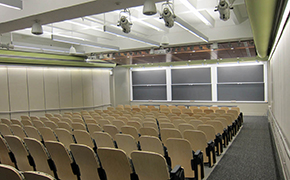Instructor Insights pages are part of the OCW Educator initiative, which seeks to enhance the value of OCW for educators.
Below, Professor Jonathan Gruber describes various aspects of how he teaches 14.01 Principles of Microeconomics.
You only really understand something when you go out in the real world and apply it.
— Prof. Jonathan Gruber
Professor Gruber wants to train students to think like economists. Economics uses elegant mathematical models to explain how people make decisions and allocate their resources—but all too often those models are taught in ways that remain disconnected from students’ own experience. In an interview on OCW’s Chalk Radio podcast, Professor Gruber shares his thoughts on bridging that gap in his course 14.01 Introductory Microeconomics (the name given to 14.01 Principles of Microeconomics in its version on the MITx platform). He says he tries to anchor learning with real-world examples; as he explains, “You only really understand something when you go out in the real world and apply it.” And those examples, he says, have to be relatable. So rather than discussing companies none of his students have heard of or commodities nobody cares about, he illustrates fundamental economic concepts with examples like Kim Kardashian’s exercise corset, Uber’s policy of surge pricing, and LeBron James’s decision not to attend college. By engaging students with accessible examples of economic principles in action, Professor Gruber helps them develop economic intuition—a sense of how the mathematical models apply in the real, seemingly chaotic world.
Curriculum Information
Prerequisites
None, although some calculus at the level of 18.01 Single Variable Calculus is used in the course.
Requirements Satisfied
Offered
Every semester
Assessment
Grade Breakdown
The students' grades were based on the following activities:
 25% Ten problem sets; only the nine highest scores count toward the final grade 25% Ten problem sets; only the nine highest scores count toward the final grade 25% Mid-term exam 25% Mid-term exam 50% Final exam 50% Final exam |
Student Information

Breakdown by Year
Mostly undergraduates, with a few graduate students also enrolled.
Breakdown by Major
The course attracts students from a variety of concentrations.
During an average week, students were expected to spend 12 hours on the course, roughly divided as follows:
Lecture
Prof. Gruber’s lecture classes met 2 times per week for 1 hour per session; 27 sessions total; mandatory attendance. Students taking the course in this format also had one recitation per week; students taking the course in an optional section format had three 1-hour section meetings per week in place of the lectures and recitation.
Recitation
Recitations, conducted by the graduate TAs, met 1 time per week for 1 hour per session; these sessions introduced new material in addition to reviewing material from the lectures.
Out of Class
Students spent time out of class completing problem sets and studying for exams.
Semester Breakdown
| WEEK | M | T | W | Th | F |
|---|---|---|---|---|---|
| 1 |  |
 |
 |
 |
 |
| 2 |  |
 |
 |
 |
 |
| 3 |  |
 |
 |
 |
 |
| 4 |  |
 |
 |
 |
 |
| 5 |  |
 |
 |
 |
 |
| 6 |  |
 |
 |
 |
 |
| 7 |  |
 |
 |
 |
 |
| 8 |  |
 |
 |
 |
 |
| 9 |  |
 |
 |
 |
 |
| 10 |  |
 |
 |
 |
 |
| 11 |  |
 |
 |
 |
 |
| 12 |  |
 |
 |
 |
 |
| 13 |  |
 |
 |
 |
 |
| 14 |  |
 |
 |
 |
 |
| 15 |  |
 |
 |
 |
 |
| 16 |  |
 |
 |
 |
 |
 No classes throughout MIT
No classes throughout MIT Lecture
Lecture Problem set due
Problem set due No class session scheduled
No class session scheduled Recitation
Recitation Mid-term exam
Mid-term examCourse Team Roles
Professor Gruber
Delivering lectures; holding regular office hours
Teaching Assistants (5)
Teaching MWF sections of the course for students in the section format; leading recitations for students in the lecture-and-recitation format; holding regular office hours.


 Room 1 of 2
Room 1 of 2 
